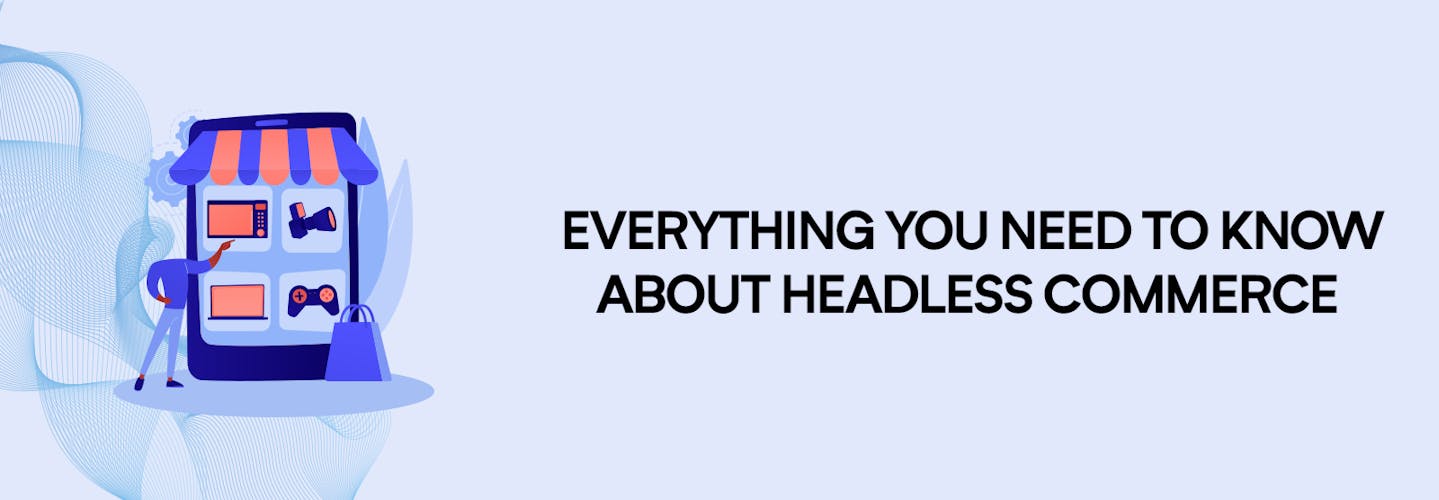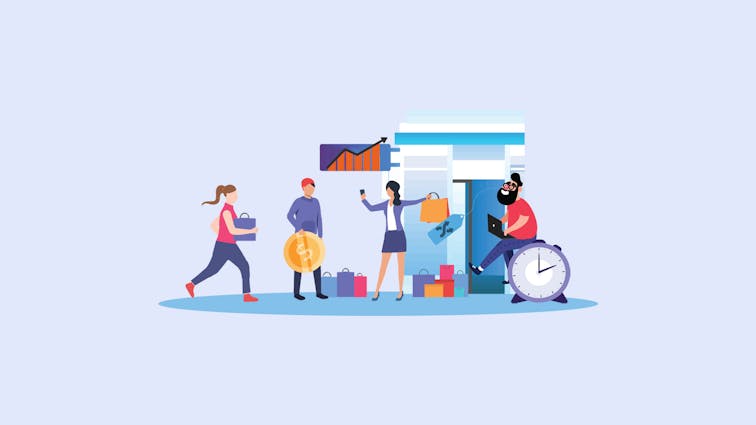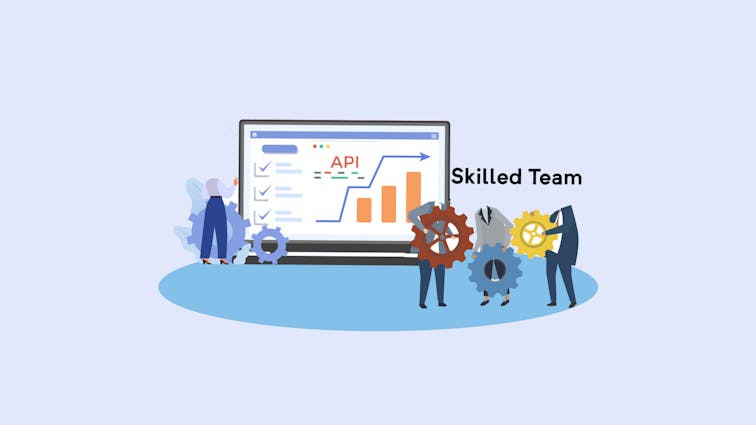
Everything You Need to Know About Headless Commerce - aasaan
You want to grow your online sales and create amazing customer experiences across multiple channels.
But you’re stuck with a traditional e-commerce platform that limits your creativity and flexibility.
You can’t update your front-end without affecting your back-end, and you can’t keep up with the latest trends and technologies.
This is a huge problem for your business, especially in 2023 when e-commerce sales are expected to grow 10.4% and reach $6.3 trillion globally.
You’re missing out on a huge opportunity to reach more customers and stand out from your competitors.
You’re also risking losing customers who are looking for more personalized, diversified, and omnichannel shopping experiences.
The solution is Headless commerce, an e-commerce architecture that separates the front-end (head) from the back-end functionality.
This allows you to update or edit your front-end without interfering with your back-end, giving you more freedom and agility to build whatever and however you want.
Headless commerce enables you to enrich the customer experience by using APIs, experience managers, and tools to deliver new functionality and experiences that engage customers and exceed their expectations.
In this article, we’ll explain what headless commerce is, why you should consider it, and how to get started with it.
So What Exactly is Headless Commerce?
Headless Commerce is one of the most transformative and agile approaches in the e-commerce industry. But what exactly does it mean?
In simple terms, Headless Commerce is an e-commerce solution where the front-end (or the “head”) is decoupled from the back-end. This separation allows for greater flexibility and scalability.
- Front-end: This is what the customers see. It’s the design, user interface, and user experience of an online store.
- Back-end: This is the engine behind the scenes. It includes databases, inventory management, and other business processes.
By separating these two layers, businesses can make changes to the front-end without affecting the back-end, and vice versa.
For instance, a business using Headless architecture can completely overhaul its website design to cater to a seasonal theme without having to touch the core e-commerce functionality.
Why is Headless Commerce Gaining Popularity?

The e-commerce landscape is evolving at a breakneck pace. With customer preferences changing rapidly, businesses need to be agile. This is where Headless Commerce shines.
- Unparalleled Flexibility: Businesses are not tied to a specific front-end technology. They can use any technology stack for the front-end, giving them the freedom to create unique customer experiences.
- Faster Time-to-Market: With the ability to work on the front-end and back-end independently, businesses can roll out new features and updates faster.
- Improved Performance: Decoupling allows for performance optimization. A faster website leads to better customer experience and potentially higher conversion rates.
According to a report, 62% of e-commerce businesses that switched to Headless Commerce saw an improvement in site performance and customer engagement.
How Does Headless Commerce Work?
At its core, Headless solutions relies on APIs (Application Programming Interfaces) to communicate between the front-end and back-end.
- APIs: These are sets of tools and protocols that allow different software applications to communicate with each other. In Headless Commerce, APIs are used to send data between the front-end and back-end.
Imagine a customer placing an order. The front-end sends a request to the back-end via an API. The back-end processes the order, updates the inventory, and sends a confirmation back to the front-end, again via an API.
This decoupled architecture allows for:
- Customization: Businesses can tailor the front-end to meet specific customer needs.
- Scalability: As the business grows, the system can easily be scaled without major overhauls.
- Omnichannel Experience: With APIs, businesses can deliver a consistent experience across various platforms such as mobile apps, websites, and IoT devices.
What Are the Benefits of Using Headless Commerce?
Headless eCommerce is not just a buzzword; it’s a powerful approach that is revolutionizing the e-commerce landscape. Let’s dive into some of the main benefits:
- Faster Website Performance: By decoupling the front-end and back-end, you can optimize each layer independently. This often leads to faster load times, which is crucial for keeping customers engaged.
- Improved Customization: Freedom in front-end technologies means you can create a truly unique customer experience. Tailor your UI/UX without any limitations imposed by traditional e-commerce platforms.
- Increased Scalability: As your business grows, so does your website. Headless Commerce makes it easier to scale your operations without overhauling your entire system.
- Easy Integration of New Technologies: Want to add a chatbot? Or maybe integrate with an IoT device? Headless Commerce makes it easier to plug in new technologies through APIs.
- Omnichannel Experience: In today’s digital age, customers interact with businesses across multiple touchpoints. Headless Commerce, with its API-driven approach, allows businesses to deliver a consistent experience across all channels.
For example, a fashion retailer with a global customer base might use Headless Commerce to create region-specific storefronts with localized content and promotions, all while maintaining a centralized inventory system.
What Are the Drawbacks of Headless Commerce?
While Headless Commerce is a powerful solution for many e-commerce businesses, it’s important to consider the potential drawbacks before making the transition. Here are some of the challenges and drawbacks associated with Headless Commerce:
- Complexity: One of the major drawbacks of Headless Commerce is its complexity. The decoupling of the front-end and back-end requires a deep understanding of APIs and integration. This can be daunting, especially for businesses without a strong technical team.
- Increased Costs: Implementing a Headless Commerce solution can be more expensive than traditional e-commerce platforms. This is due to the need for custom development, ongoing maintenance, and potentially higher hosting costs.
- Resource Intensive: Headless approach often requires more resources in terms of development and maintenance. Businesses need to allocate time and manpower to manage both the front-end and back-end separately.
- Lack of Out-of-the-Box Features: Traditional e-commerce platforms often come with a range of out-of-the-box features. With Headless Commerce, businesses might need to build these features from scratch, which can be time-consuming.
- Potential for Inconsistencies: With the front-end and back-end operating independently, there is potential for inconsistencies if not properly managed. This can lead to issues with data synchronization and user experience.
- Steep Learning Curve: For businesses accustomed to traditional e-commerce platforms, the transition to Headless Commerce can involve a steep learning curve. This can slow down the initial development process.
- Reliance on APIs: Headless Commerce is heavily reliant on APIs for communication between the front-end and back-end. If an API experiences issues or downtime, it can affect the entire e-commerce operation.
For example, a business that switches to Headless architecture without proper planning might find itself facing unexpected costs and complexities, especially if they lack the technical expertise to manage the decoupled system effectively.
What Are the Challenges of Implementing Headless Commerce?
While Headless Commerce is powerful, it’s not without its challenges:
- Higher Development Costs: Building and maintaining separate systems can be more costly, especially if you require specialized development skills.
- Need for Specialized Expertise: Implementing a headless architecture requires a team with expertise in both front-end and back-end technologies.
- Complexity in Management: Managing two separate systems can be more complex, especially when it comes to ensuring that they communicate effectively through APIs.
It’s important to weigh these challenges against the benefits to determine if Headless Commerce aligns with your business goals and resources.
How Can I Get Started with Headless architecture?

Taking the plunge into Headless approach requires a plan. Here’s how you can get started:
- Assess Your Needs: Determine if Headless architecture aligns with your business goals and needs.
- Assemble a Skilled Team: Ensure you have access to developers with expertise in Headless Commerce.
- Choose Your Technology Stack: Select the front-end and back-end technologies that best suit your needs.
- Develop Your APIs: Create the APIs that will allow your front-end and back-end to communicate.
- Test and Optimize: Before going live, thoroughly test your system and optimize for performance.
- Launch and Monitor: Once you’re confident in your setup, go live and continuously monitor and optimize your system.
Remember, transitioning to Headless Commerce is a significant undertaking. It’s important to approach it with a clear strategy and the right resources.
What Are Some Examples of Headless Commerce Solutions?
When it comes to implementing Headless Commerce, businesses have a plethora of platforms to choose from. Each platform comes with its own set of features and capabilities. Here are some of the popular Headless Commerce platforms:
- Aasaan: Aasaan offers a modular Headless Commerce platform that simplifies the implementation process. It features strong APIs and a user-friendly interface, enabling businesses to scale and adapt to changing needs effortlessly.
- BigCommerce: Known for its robust APIs and flexibility, BigCommerce is a popular choice for businesses looking to go headless. It allows for seamless integration with various CMS and DXP solutions.
- Shopify Plus: Shopify Plus offers a headless solution that allows businesses to build custom storefronts using their preferred technology stack. It’s known for its ease of use and extensive app ecosystem.
- Magento: Magento, an Adobe company, offers a powerful Headless Commerce solution. It’s highly customizable and is favored by businesses looking for deep integrations and extensive features.
- CommerceTools: CommerceTools provides a cloud-native Headless Commerce platform that focuses on APIs and microservices. It’s ideal for businesses looking for a highly scalable and flexible solution.
- WooCommerce: As a popular open-source e-commerce platform, WooCommerce can be extended into a Headless Commerce solution through the use of plugins and custom developments. This allows businesses to leverage the power of WordPress while creating custom front-end experiences.
- Elastic Path: Elastic Path is a flexible Headless Commerce platform engineered for high-performing implementations. It provides an API-first approach and a broad range of ecommerce capabilities, making it suitable for businesses with complex requirements.
Related: 24 Best Examples of Headless Commerce.
How Can Headless Commerce Improve the Customer Experience?
Headless Commerce can significantly enhance the customer experience in several ways:
- Tailored Experiences: With the flexibility to use any front-end technology, businesses can create highly customized and tailored experiences for different customer segments.
- Faster Load Times: By optimizing the front-end independently, websites can achieve faster load times, which is crucial for customer satisfaction and conversion rates.
- Consistent Omnichannel Experience: Headless Commerce enables businesses to deliver a consistent experience across various channels, whether it’s a web, mobile app, or in-store.
- Quick Adaptation to Trends: The ability to make swift changes to the front-end allows businesses to quickly adapt to emerging trends and customer preferences.
For example, a business can use Headless architecture to create a personalized homepage for each visitor, based on their browsing history and preferences.
Is Headless Commerce Right for My Business?
While Headless Commerce offers several benefits, it’s not a one-size-fits-all solution. Whether it’s right for your business depends on several factors.
- Business Size and Complexity: Larger businesses with complex needs may benefit more from the flexibility and scalability offered by Headless Commerce.
- Technical Expertise: Implementing and managing a Headless Commerce solution requires a certain level of technical expertise. Businesses with a strong IT team or willing to invest in one may find Headless Commerce more suitable.
- Customer Experience Needs: If your business prioritizes delivering unique and personalized customer experiences, Headless storefront builder can be a great fit.
- Multi-Platform Operations: If you operate on multiple channels (web, mobile, social media), Headless Commerce allows you to maintain a consistent experience across all platforms.
Ask yourself: Does my business require flexibility in design? Do I need to operate on multiple channels? If the answer is yes, Headless solution might be the right choice.
Are There Any Case Studies of Successful Headless Commerce Implementations?
Absolutely! Many businesses have reaped the benefits of Headless Commerce. Here are a few examples:
- Princess Polly: An Australian fashion retailer, Princess Polly, switched to Headless architecture to improve website performance and customization. As a result, they saw a 30% increase in conversion rates.
- Coca-Cola: Coca-Cola used a Headless Commerce approach to unify their numerous brands under a single, scalable platform. This allowed them to deliver a consistent experience across various channels and regions.
- Burberry: Luxury fashion brand Burberry adopted Headless Commerce to create a highly personalized and immersive online shopping experience. This led to increased customer engagement and online sales.
Want to learn more about headless commerce?
Are you excited about the possibilities that headless architecture offers?
Do you want to see how it can transform your business?
We’d love to show you! Feel free to schedule a demo or request more information.
We’re here to help you navigate the exciting world of headless commerce.
Remember, the future is not something that just happens. It’s something you create.
So, why not create a future where your business is at the forefront of innovation and customer satisfaction? With headless architecture, that future is within your reach.
Let’s embrace the future, together!
Thank you for joining us on this journey. We can’t wait to see where headless architecture takes you next!
Conclusion:
In conclusion, Headless Commerce is a powerful approach that allows businesses to provide highly customized, flexible, and seamless online experiences to their customers.
By decoupling the front-end and back-end systems, businesses can pivot quickly to market trends and create consistent omnichannel experiences.
However, it’s essential to consider factors such as business size, technical expertise, and customer experience needs before deciding if Headless Commerce is the right choice for your business.
By reviewing case studies of successful implementations and exploring the resources available, you can make an informed decision and potentially transform your e-commerce venture.
FAQ’s:
1. What is an example of headless eCommerce?
An example of headless eCommerce is a retail business using a platform like aasaan for managing its backend operations (like inventory and order management), while using a custom-built frontend to provide a unique shopping experience. This allows the business to make changes to the user interface without affecting the backend operations.
2. What is headless vs non-headless eCommerce?
Headless eCommerce refers to the decoupling of the frontend and backend of an eCommerce platform. This allows for greater flexibility and customization of the user interface. Non-headless eCommerce, on the other hand, has a tightly coupled frontend and backend, limiting customization options and making changes more complex.
3. Why choose headless commerce?
Businesses choose headless commerce for its flexibility, scalability, and speed. It allows for quick updates to the frontend without affecting backend operations, making it easier to adapt to market trends and customer preferences. It also enables businesses to provide a unique, personalized shopping experience, which can lead to increased customer satisfaction and sales.
4. Is headless commerce the future?
Many experts believe that headless commerce is the future of eCommerce due to its flexibility and adaptability. As customer expectations continue to evolve, businesses need to be able to quickly adapt their online presence. Headless commerce allows for this, making it a popular choice for businesses looking to future-proof their eCommerce operations.
5. What is monolith vs headless commerce?
Monolithic eCommerce refers to platforms where the frontend and backend are tightly coupled. Changes to one can affect the other, making updates and customization more complex. Headless commerce, on the other hand, separates the frontend and backend, allowing for independent updates and greater customization options. This makes headless commerce more adaptable and scalable than monolithic eCommerce.








